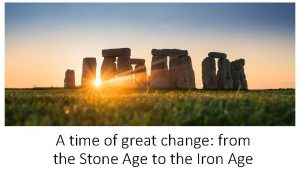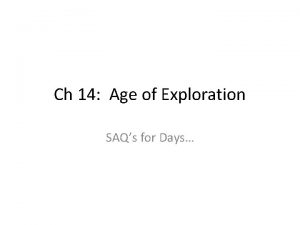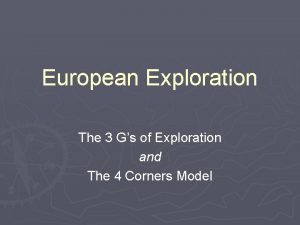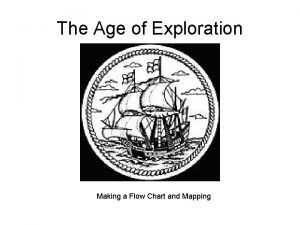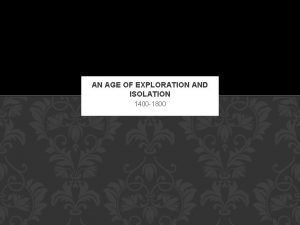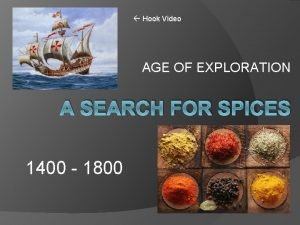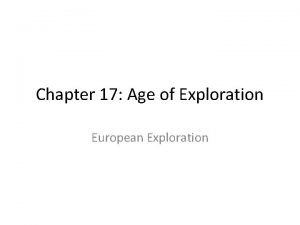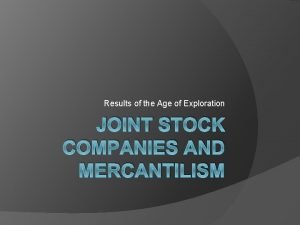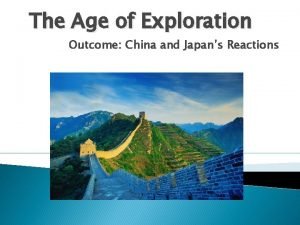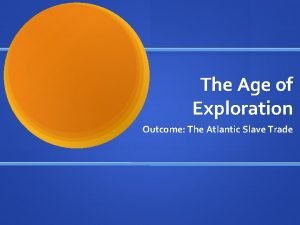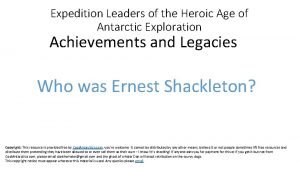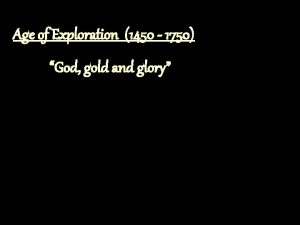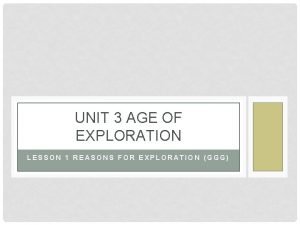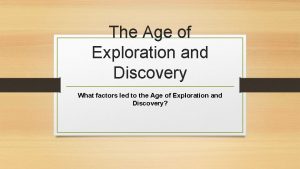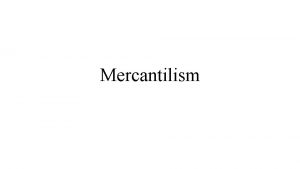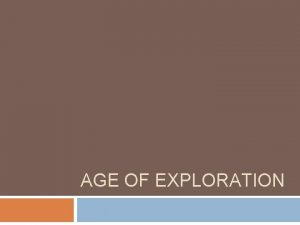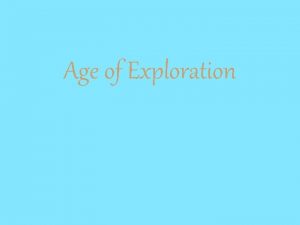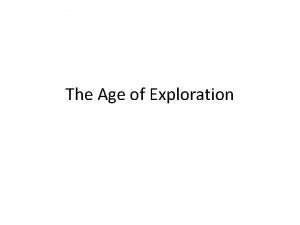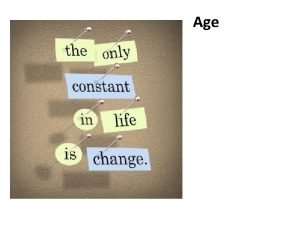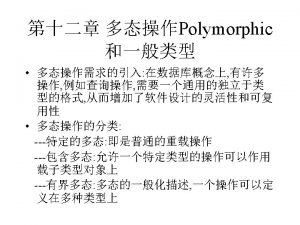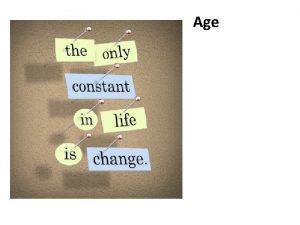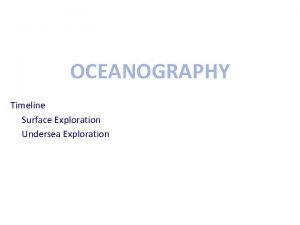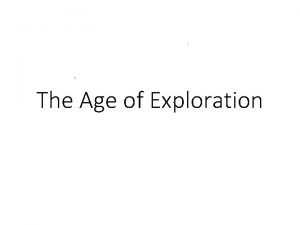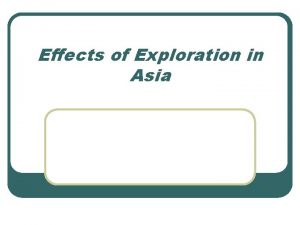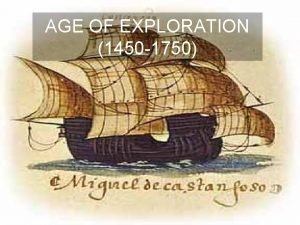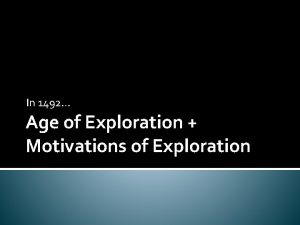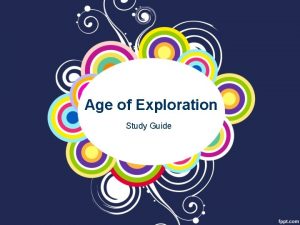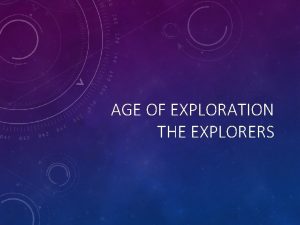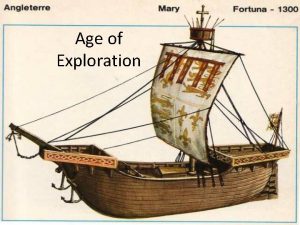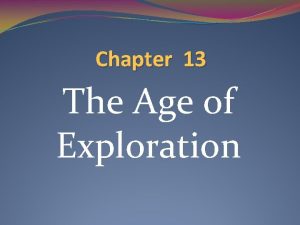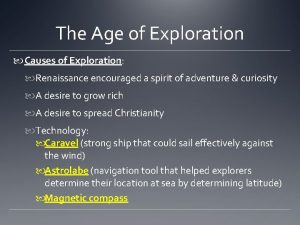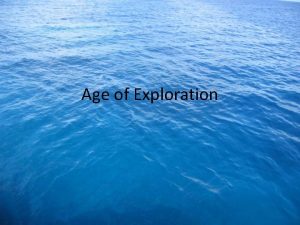Age of Exploration AGE OF EXPLORATION w The





















































- Slides: 53

Age of Exploration

AGE OF EXPLORATION w The 16 th century was the age of exploration w Technological changes made longer voyages possible, while the demands for commerce provide the incentive w There were fortunes to be made and the search was on for new sources of gold Portuguese sailing vassal, circa 16 th century

The modern world exists in a state of cultural, political, and economic globalization. During the fifteenth and sixteenth centuries two nations, Portugal and Spain, pioneered the European discovery of sea routes that were the first channels of interaction between all of the world's continents, thus beginning the process of globalization in which we all live today.


'Lapis Polaris Magnes'. -- A Renaissance navigator

Causes for the Age of Exploration w A desire to find a new route to the riches of Asia - to bypass Italian “middlemen” w Curiosity about the world inspired by the Crusades and the tales of Marco Polo w Commercial revolution resulted in capitalist investments in overseas exploration w Religious desire to convert pagans w Search for knowledge, adventurism

A Great Age of Exploration w Portugal led the way – very profitable w New Technology – – improved maps astrolabe compass caravel w The three “Gs” – God – Glory – Gold w Spirit of adventure

Technological Advances ‡Scholars at Prince Henry's school of navigation improved three mariners' tools: the astrolabe, the triangular quadrant, and the compass. ‡The astrolabe measures the angle of stars above the horizon line. ‡The quadrant measures the height of stars or the sun above the horizon line.

Technological Advances w Advances in technology such as the astrolabe and the compass made ocean navigation more exact. w Keith’s astrolabe page


Italian City-States w Had a monopoly on existing Mediterranean trade w Had little interest in investing in risky sea explorations w Spain and Portugal would lead the way in exploration

Prince Henry the Navigator w Set up a school for sailors 1450 w Secured financing for expeditions w Sent explorers down the coast of Africa to outflank muslims & spread Christianity

PORTUGAL MAKES GAINS Da Gama ‘s route, left, and portrait w By the 1480 s, Portuguese outposts extended to the equator and in 1487 Bartolomeu Dias rounded the tip of Africa and opened the eastern shores of Africa to Portuguese traders w A decade later, Vasco da Gama rounded the Cape of Good Hope and crossed the Indian Ocean

Bartholomeu Dias w In 1488, Dias reached the southern tip of Africa, later called the Cape of Good Hope. w Died at sea when ship sunk, 1500 w Set stage for route to India

Vasco da Gama w In 1498 da Gama founded the tip of Africa and reached India. w The all-water route, though long, was easier, safer, and far more profitable than over-land routes.

Christopher Columbus w Columbus hoped to find a route to the east by sailing west. w In 1492 he discovered what would become known as “The New World”.

The Voyages of Columbus w Columbus made four voyages to the “New World”. w Between 1493 -1496 he attempted to set up a colony on Hispaniola. w The colony on Hispaniola failed. § He was buried wearing the chains he wore after being arrested on third voyage

Columbus’ Four Voyages



WHY IS CHRISTOPHER COLUMBUS SO IMPORTANT? w When Columbus left Spain in 1492, most people in the world thought there were only three large land masses: Europe, Asia, and Africa. Although he didn't realize it, it was Columbus who proved that idea wrong. w Unlike other explorers who only wanted to trade or travel, Columbus built settlements in the New World. The settlements were created with the intention of having a continuing relationship with the peoples of the New World.

WHY IS CHRISTOPHER COLUMBUS SO IMPORTANT? w Columbus's explorations, discoveries, and settlements led to enormous changes in the world. These changes brought wealth and the possibilities of a new life in a New World to some individuals. These same changes brought disaster to others. w Even today, more than 500 years after his first voyage, Columbus is praised by some and condemned by others. His explorations made it possible for Europeans to begin a new life in the colonies of the New World. His discoveries started the migration of Europeans and their ways of life to the New World.

Ferdinand Magellan w In 1519 Magellan’s crew completed the first circumnavigation of the earth.

Ferdinand Magellan w Magellan reached the Philippine Islands in 1521. w Magellan was killed battling the inhabitants of the Philippine Island of Mactan.

Other Voyages of Exploration


The English, French, & Dutch French English Dutch Spanish Portuguese w Spain and Portugal remained concentrated in South and Central America. w The exploration of North America was conducted by England France. w The Dutch concentrated on challenging the Portuguese in the East Indies.


Looking for “El Dorado”

European Empires in the Americas

The Colombian Exchange w. Diseases w. Culture w. Agricultural products

The Blending of Cultures w European w Native American w African


PUBLIC HEALTH ISSUES w Native Americans, although originally Asian, had lost their immunity to European diseases w Measles, smallpox and influenza killed tens of millions of native Americans w Europeans, too, experienced exposure to illness when various venereal diseases impacted them


The “Columbian Exchange” v Squash v Avocado v Peppers v Sweet Potatoes v Turkey v Pumpkin v Tobacco v Quinine v Cocoa v Pineapple v Cassava v POTATO v Peanut v TOMATO v Vanilla v MAIZE v Syphilis v Trinkets v Liquor v GUNS v Olive v COFFEE BEAN v Banana v Rice v Onion v Turnip v Honeybee v Barley v Grape v Peach v SUGAR CANE v Oats v Citrus Fruits v Pear v Wheat v HORSE v Cattle v Sheep v Pigs v Smallpo v Flu v Typhus v Measles v Malaria v Diptheria v Whooping Cough x

Treasures from the Americas!

African Slave Trade

African Cultural Influences w European sugar craze – The Spanish and Portuguese began to import African slaves to work Brazilian and Caribbean sugar plantations w Exploitation of Central and South American gold and silver deposits – the same use of African slave labor

The Colonial Class System Peninsulares Mestizos Native Indians Creoles Mulattos Black Slaves

Administration of the Spanish Empire in the New World 1. Encomienda or forced labor. 2. Council of the Indies. Viceroy. New Spain and Peru. 3. Papal agreement.

Father Bartolomé de Las Casas New Laws --> 1542

There was a concern that Spain and Portugal would have conflicting territorial claims, so a treaty was proposed in which Spain would claim lands to the west of a north-south trending meridian, and Portugal could claim lands to the east. June 7, 1494

New Colonial Rivals

Impact of European Expansion 1. Native populations ravaged by disease. 2. Influx of gold, and especially silver, into Europe created an inflationary economic climate. 3. New products introduced across the continents [“Columbian Exchange”]. 4. Deepened colonial rivalries.

© 2004 Wadsworth, a division of Thomson Learning, Inc. Thomson Learning™ is a trademark used herein under license. 5. New Patterns of World Trade

Cycle of Conquest & Colonization Explorers Conq u istad ores Perm a Set nent tler s M is si on ar ie s Official European Colony!

Do You Know… Where they explored?

If they were sailing under the Portuguese flag? If they were sailing under the English flag? If they were sailing under the French flag? If they were sailing under the Spanish flag? If they were sailing under the Dutch flag?

Results of Exploration w Overseas expansion led to increased power and wealth for European powers w Christianity and the culture of Western Europe spread throughout the world. w The ethnocentric attitudes of Europeans led to the mistreatment of native peoples. w Trans-Atlantic Slave Trade began

Ortelius world map (Antwerp, 1570)

From "World Map Drawn in a Fool's Head. " Ca. 1590. Bibliothèque Nationale, Paris.

CONCLUDING THOUGHTS ON AGE OF EXPLORATION w The Age of Exploration was filled with good intentions and important cultural exchanges of products and ideas that altered European and world history w However, it had a dark side – disease, forced labor and slave plantations left a lasting legacy as well
 Iron age dates
Iron age dates Iron age bronze age stone age timeline
Iron age bronze age stone age timeline Saq-14
Saq-14 Pineda explorer route
Pineda explorer route 4 g's of exploration
4 g's of exploration Age of exploration diagram
Age of exploration diagram Age of exploration jeopardy
Age of exploration jeopardy Who paid for jacques cartier's voyage
Who paid for jacques cartier's voyage God gold and glory age of exploration
God gold and glory age of exploration An age of exploration and isolation
An age of exploration and isolation The age of exploration outcome china and japan's reactions
The age of exploration outcome china and japan's reactions The age of exploration outcome the atlantic slave trade
The age of exploration outcome the atlantic slave trade Age of exploration videos
Age of exploration videos The three g's of european exploration
The three g's of european exploration Age of exploration motives
Age of exploration motives Triangular trade vs columbian exchange
Triangular trade vs columbian exchange Joint stock company age of exploration
Joint stock company age of exploration The age of exploration definition
The age of exploration definition What was the outcome of china's age of exploration?
What was the outcome of china's age of exploration? The age of exploration outcome the atlantic slave trade
The age of exploration outcome the atlantic slave trade Heroic age of antarctic exploration
Heroic age of antarctic exploration God gold and glory motivations for the age of exploration
God gold and glory motivations for the age of exploration Age of exploration gold
Age of exploration gold Age of exploration glory
Age of exploration glory Mercantilism during the age of exploration
Mercantilism during the age of exploration The age of exploration lesson 1
The age of exploration lesson 1 What factors led to the age of exploration
What factors led to the age of exploration Pizarro map
Pizarro map Mercantilism
Mercantilism Age of exploration webquest
Age of exploration webquest Diễn thế sinh thái là
Diễn thế sinh thái là đại từ thay thế
đại từ thay thế Vẽ hình chiếu vuông góc của vật thể sau
Vẽ hình chiếu vuông góc của vật thể sau Công của trọng lực
Công của trọng lực Tỉ lệ cơ thể trẻ em
Tỉ lệ cơ thể trẻ em Thế nào là mạng điện lắp đặt kiểu nổi
Thế nào là mạng điện lắp đặt kiểu nổi Lời thề hippocrates
Lời thề hippocrates Vẽ hình chiếu đứng bằng cạnh của vật thể
Vẽ hình chiếu đứng bằng cạnh của vật thể độ dài liên kết
độ dài liên kết Quá trình desamine hóa có thể tạo ra
Quá trình desamine hóa có thể tạo ra Môn thể thao bắt đầu bằng chữ đua
Môn thể thao bắt đầu bằng chữ đua Hình ảnh bộ gõ cơ thể búng tay
Hình ảnh bộ gõ cơ thể búng tay Khi nào hổ con có thể sống độc lập
Khi nào hổ con có thể sống độc lập điện thế nghỉ
điện thế nghỉ Các loại đột biến cấu trúc nhiễm sắc thể
Các loại đột biến cấu trúc nhiễm sắc thể Nguyên nhân của sự mỏi cơ sinh 8
Nguyên nhân của sự mỏi cơ sinh 8 Trời xanh đây là của chúng ta thể thơ
Trời xanh đây là của chúng ta thể thơ Gấu đi như thế nào
Gấu đi như thế nào Thiếu nhi thế giới liên hoan
Thiếu nhi thế giới liên hoan Vẽ hình chiếu vuông góc của vật thể sau
Vẽ hình chiếu vuông góc của vật thể sau Một số thể thơ truyền thống
Một số thể thơ truyền thống Thế nào là hệ số cao nhất
Thế nào là hệ số cao nhất Lp html
Lp html Sơ đồ cơ thể người
Sơ đồ cơ thể người

